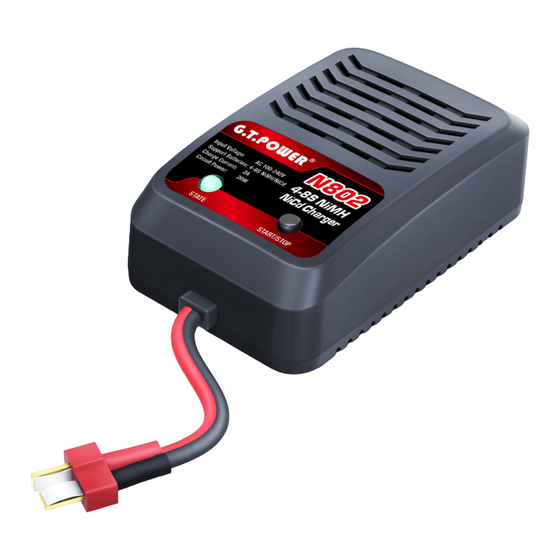
Advertisement
N802 4-8S NiMH / NiCd Charger Instructions
The N802 charger is a smart charger which is specifically designed for 4-8 cell NiMH / NiCd batteries. Itʼs
small size and easy operation makes it an ideal charger for many applications.
As part of Safe LiPo charging we always recommend never to leave a charging battery unattended.
Specification:
1. Input: AC100-240V, 50/60Hz
2. Output: DC4.8v ‒ 16v
3. Supports battery type: 4-8 cell NiMH / NiCd
4. Current output: 2A / 20W
5. LED charging status:
Standby - Flashing Green
Charging - Constantly Red
Finish - Constantly Green
6. Output Port: Deans (HCT) / Tamiya
Operation Instruction:
1. Connect the charger with the supplied power
cord to your mains socket, the AC input is
AC100-240V, 50/60Hz.
2. The charger will enter the stand-by mode and
the LED will be flashing Green.
3. Connect your battery to the charger and
momentarily press the start button, the LED
will illuminate Red while charging.
4. When the charge cycle is complete, the LED
will illuminate Green. Please disconnect the
battery.
5. If the charge cycle needs to be stopped
press the start/stop button to stop charging.
Note: It is normal for the Battery and charger
to rise in temperature whilst charging but
should never get too hot. If unsure please
unplug the charger and battery and seek
advice.
Caution:
1. Please read the manual completely and carefully before operation.
2. Under no circumstances should any other battery type be charged on this charger other than the ones
specified. If any other battery is connected it may cause the battery to explode.
3. The charger must always be supervised while charging is in progress.
4. Never charge in damp, rainy or humid environments.
5. If there is any abnormality in the charging processes please disconnect the charger from the mains
power supply and then disconnect the battery from the charger if it is safe to do so.
6. Do not attempt to charge two batteries at the same time
Correct charging:
Battery may get warm to the touch, but never hot.
Charge too fast or for too long a time period:
Battery could get hot and catch fire!
AC POWER
CHARGE PLUG
T-CONNECTOR
Advertisement
Table of Contents

Summary of Contents for G.T.Power N802
- Page 1 N802 4-8S NiMH / NiCd Charger Instructions The N802 charger is a smart charger which is specifically designed for 4-8 cell NiMH / NiCd batteries. Itʼs small size and easy operation makes it an ideal charger for many applications. As part of Safe LiPo charging we always recommend never to leave a charging battery unattended. AC POWER Specification: 1. Input: AC100-240V, 50/60Hz 2. Output: DC4.8v ‒ 16v 3. Supports battery type: 4-8 cell NiMH / NiCd 4. Current output: 2A / 20W 5. LED charging status: Standby - Flashing Green Charging - Constantly Red Finish - Constantly Green 6. Output Port: Deans (HCT) / Tamiya CHARGE PLUG T-CONNECTOR Operation Instruction: 1. Connect the charger with the supplied power cord to your mains socket, the AC input is AC100-240V, 50/60Hz. 2. The charger will enter the stand-by mode and the LED will be flashing Green. 3. Connect your battery to the charger and momentarily press the start button, the LED will illuminate Red while charging. Correct charging: 4. When the charge cycle is complete, the LED Battery may get warm to the touch, but never hot. will illuminate Green. Please disconnect the battery. 5. If the charge cycle needs to be stopped press the start/stop button to stop charging. Note: It is normal for the Battery and charger ...
- Page 2 Conformity Declaration: G.T.POWER N802 satisfies all relevant and mandatory CE directives and FCC Part 15 Subpart B. The product has been tested to meet the following technical standards: This marking indicates that this product should not be disposed with other household wastes throughout the EU.








Need help?
Do you have a question about the N802 and is the answer not in the manual?
Questions and answers